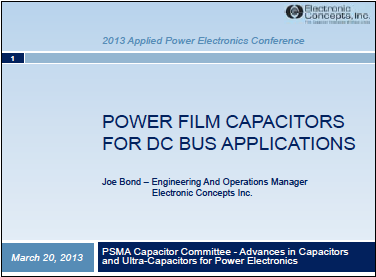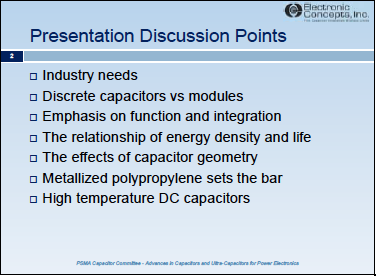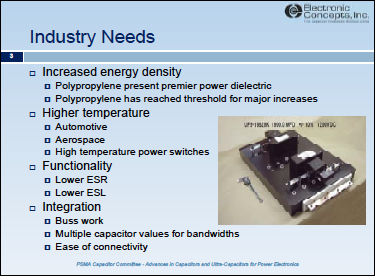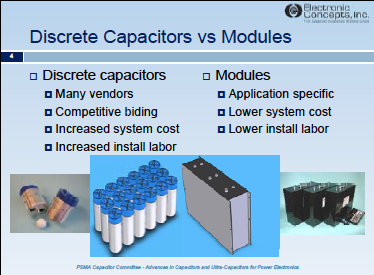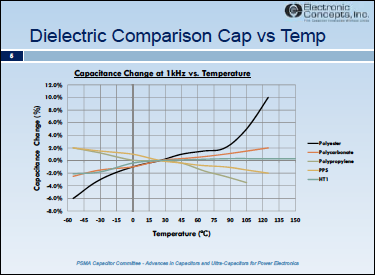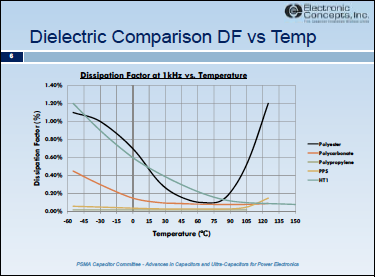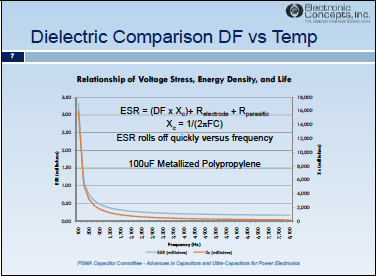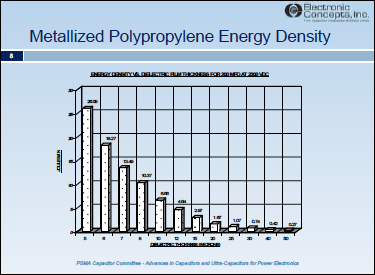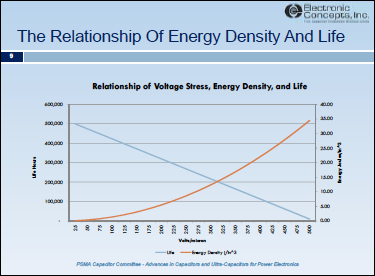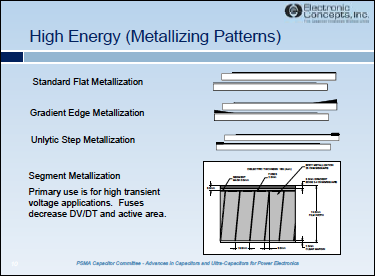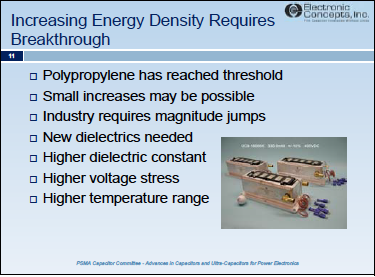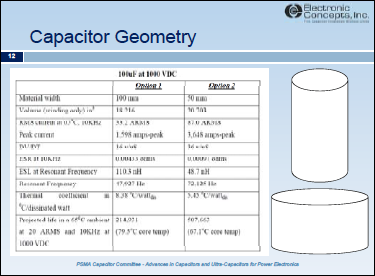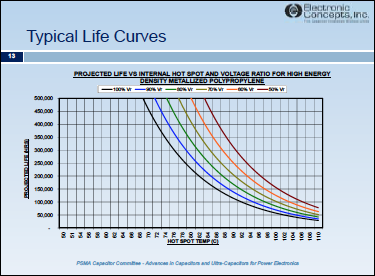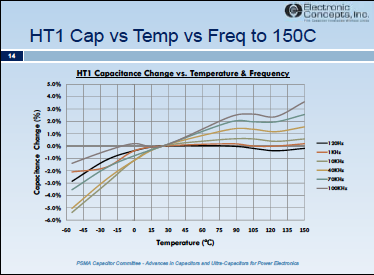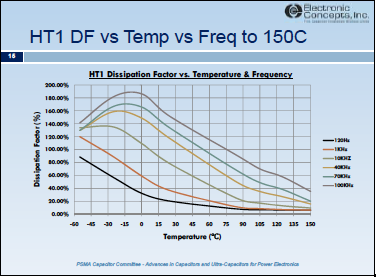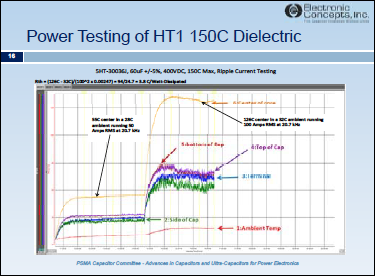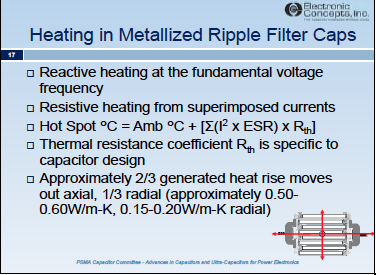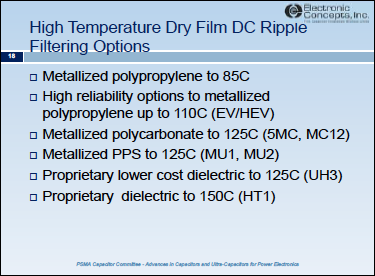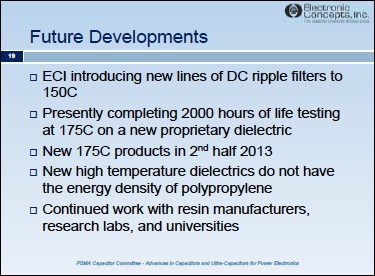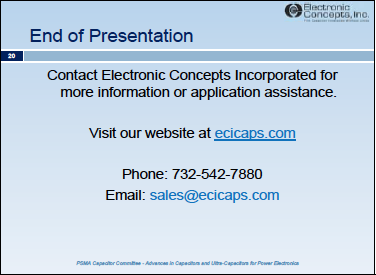Home > Tech Tools > Technical Papers > Power Film Capacitors for DC Bus Applications
This presentation explores the state-of-the-art in metallized dielectric DC link capacitors. The discussion is based on dry constructions. The present industry demands are discussed, system level approaches for discrete versus modular capacitors, factors affecting capacitor design, and future development trends. Metallized polypropylene is discussed as the premier power film and how the film has reached its potential. The need for a dielectric breakthrough is required to significantly move the industry forward.
The industry is looking for a significant increase in energy density. The goal established by the DOE is 4 joules/cc (65.6 joules/cubicinch) with temperature ranges to 200C. The present state-of-theart for DC link designs to 85C are between 2-6 joules/cubic-inch. It will require a new dielectric with significantly higher dielectric constant and voltage strength. ECI works with resin manufacturers, universities, and government labs researching next generation polymers. Although some dielectrics under study show much higher dielectric constants, generally they are lower voltage strength than polypropylene. Higher dielectric constant polymers as well as higher temperature polymers also show a tendency to have higher loses thus increasing hot spot temperatures during ripple current filtering and offsetting gains in temperature range.
Different philosophies exist between customers. Some pursue cost competitiveness at component levels through discrete capacitors with many vendors to drive savings through competitive biding. Others pursue cost competitiveness at system levels by maximizing the value and functionality of modular approaches specific to the customer’s system. The module approach is increasing in popularity as customers realize they can eliminate extensive bus bars and laminates while lowering installation costs of multiple discrete capacitors. Modules allow the integration of functional components such as laminate bus bars, multiple capacitor bandwidths, bleed resistors, and externally mounted devices.
This graph shows multiple dielectrics for capacitance stability versus temperature at 1kHz. Film dielectrics have excellent stability over temperature compared to other technologies like electrolytic capacitors.
This graph shows multiple dielectrics for dissipation factor versus temperature at 1kHz. Film dielectrics generally have decreased loses with increased temperature. Polyester has an increase in loses as the temperature surpasses the glass transition temperature. The capacitance values required in DC links is generally high enough to mitigate higher DF since the reactive portion of the ESR calculation rolls off quickly versus frequency.
This graph shows that ESR rolls down quickly with increasing frequency following the capacitive reactance. The lowest value of ESR is found at resonant frequency where the capacitive and reactive inductances cancel. The remaining resistance is relative to the electrode and small parasitic loses normal to the construction and connections. Typically these losses are a fraction of a milliohm. The larger the capacitance value the quicker the ESR drops versus frequency.
Energy density is a function of dielectric constant and voltage stress. Emphasis has been on increasing voltage strength since it is a exponential factor and dielectric constant is a linear factor as expressed by E=1/2 CV2. This chart shows the energy density realized for a capacitor winding of 200uF at various film thickness in metallized polypropylene for a 2300Vdc rating. Older high reliability designs begin less than 1 joule/cubic-inch. The present state-of-the-art ranges between 2 and 6 joules/cubic-inch for DC links in the operating temperature range of 85-105C . As the voltage stress increases the maximum ambient temperature decreases.
Dielectric voltage strength decreases with increasing temperature. As the volts/micron stress increases, energy density increases, but life expectancy decreases. Maximum temperature range also decreases to avoid avalanche breakdown of the dielectric under voltage stress. These conflicting factors complicate the goal of magnitude jumps in energy density at temperatures exceeding 105C.
Increasing energy density by increasing voltage stress is accomplished through the design of the electrode vapor deposited on the dielectric. Different approaches include reinforced edge designs with light metal body deposits or segment metallization. ECI uses reinforced edge designs with light metal for DC applications. Segment metallization began as a technique to meet lightning surge tests of AC capacitors. However caution is needed when specifying segment metallization as fuses connecting the reinforced edge to the active body metallization limit peak current surges. The total cross-sectional width of all fuses summed together can be as little as 20% of the active length of the capacitor. The peak current, or DV/DT rating of a film capacitor is a function of the edge connection to the end spray in amps/inch of winding length. Potential “running sparks” can result when a sufficient number of fuses open and the remaining fuse connections are insufficient to support normal peak currents of the application.
Polypropylene has excellent properties including low loses, lightweight, high voltage strength, and low cost. However large jumps in energy density will take a new dielectric. Polypropylene has an upper temperature range of 105C. The melt point of polypropylene is approximately 165-170C. Research for dielectrics exhibiting characteristics of polypropylene at temperatures to 200C has been an industry objective for many years.
The geometry of the capacitor winding can drastically affect the operating characteristics. The designs shown represent metallized polypropylene capacitors of 100uF at 1000Vdc. The film thickness is the same for both designs and the film width is changed to show the difference between a 100mm width and a 50mm width. The short stubby capacitor has slightly higher volume due to fixed free-margin and offset widths. ESL is a function of width and decreases for the narrow winding. The capacitance is a function of total active area which is the same for both units. The shorter width requires a longer winding length which increases peak current, decreases ESR, increases ampacity, and exhibits lower heat rise resulting in longer life.
Typical life curves of high energy density metallized polypropylene for EV/HEV applications to 110C rating. Geometry as discussed can increase the life by decreasing the ESR and internal heating. De-rating of the capacitor rating also extends capacitor life. At present polypropylene has reached the threshold for dramatic increases in energy density and operating temperature range.
ECI owns and operates a solvent cast dielectric plant for polymers like polycarbonate, polysulfone, PEI, and other proprietary dielectrics. HT1 is a proprietary dielectric exhibiting the highest peak current of any film dielectric prompting the introduction of the HT1 series of snubber capacitors. HT1 is also a high temperature alternative for ripple current filtering. HT1 has completed life testing at 150C for 2000 hours.
This graph shows the decreasing dissipation factor of HT1 solvent cast polymer for various frequencies to 150C. This characteristic makes HT1 a good choice for ripple filtering applications in DC links.
This is the thermal graph of an HT1 60uF capacitor running initially at 50Arms at 20kHz and then increased to 100Arms. The thermal resistance coefficient is calculated as 3.8C/Wattdissipated. The unit had a 2.47 milliohm ESR at 20kHz. Thermocouples strategically placed as indicated record the temperatures of the unit over time with a data logger.
In a DC ripple filtering application, heat rise is determined as a function of I2ESR and the thermal coefficient Rth. Thermal coefficients are different for different capacitor geometries. Consider the geometries of a hockey puck and a soda can. The hockey puck has higher RMS current capability, lower ESR and ESL, and lower thermal resistance as a function of distance from the center to the end of the capacitor. The soda can has better volume efficiency as a function of fixed margins and offsets, but also higher ESR and ESL resulting in lower current potential and higher thermal resistance.
Metallized polypropylene designs offer the highest energy density of present technologies. However other technologies are presently offered for operation to 150C.
Work continues to find higher temperature and higher energy density film dielectrics. Present developments include 175C capacitors in the second half of 2013. Research and testing new polymers to 200C continues with the potential for 2015 introduction.
ECI research continues to pursue the panacea of low loss, high temperature, and cost effective dielectrics for use in power electronics.

